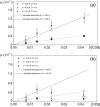Structural characterization of cationic liposomes loaded with sugar-based carboranes
- PMID: 15489297
- PMCID: PMC1305031
- DOI: 10.1529/biophysj.104.049080
Structural characterization of cationic liposomes loaded with sugar-based carboranes
Abstract
In this article we report the physicochemical characterization of cationic liposomes loaded with orthocarborane and two of its sugar-containing derivatives. Carboranes are efficient boron delivery agents in boron neutron capture therapy, an anti-cancer treatment based on neutron absorption by 10B nuclei. Cationic liposomes were prepared using the positively charged DOTAP and the zwitterionic DOPE, as a helper lipid. These liposomes are currently used in gene therapy for their ability in targeting the cell nucleus; therefore they can be considered appropriate vectors for boron neutron capture therapy, in the quest of reducing the high boron amount that is necessary for successful cancer treatment. Boron uptake was determined by an original in situ method, based on neutron absorption. The structural properties of the loaded liposomes were studied in detail by the combined use of small angle x-ray scattering and small angle neutron scattering. These techniques established the global shape and size of liposomes and their bilayer composition. The results were discussed in term of molecular properties of the hosted drugs. Differences found in the insertion modality were correlated with the preparation procedure or with the specific shape and lipophilic-hydrophilic balance of each carborane.
Figures












References
-
- Arleth, L. D., I. S. Posselt, K. Pedersen, D. Mortensen, C. L. Gazeau, and T. N. Zemb. 1997. Small-angle scattering study of tac8: a surfactant with cation complexing potential. Langmuir. 13:1887–1896.
-
- Barth, R. F. 2003. A critical assessment of boron neutron capture therapy: an overview. J. Neuro Onchol. 62:1–5. - PubMed
-
- Braun, K., G. Wolber, W. Waldeck, R. Pipkorn, J. Jenne, R. Rastert, V. Ehemann, A. Eisenmenger, H. Corban-Wilhelm, I. Braun, S. Heckl, and J. Debus. 2003. The enhancement of neutron irradiation of HeLa-S cervix carcinoma cells by cell-nucleus-addressed deca-p-boronophenylalanine. Eur. J. Med. Chem. 38:587–595. - PubMed
-
- Cantù, L., M. Corti, E. Del Favero, M. Dubois, and T. N. Zemb. 1998. Combined small-angle x-ray and neutron scattering experiments for thickness characterization of ganglioside bilayers. J. Phys. Chem. B. 102:5737–5743.
-
- Cevc, G. editor. 1993. Phospholipids Handbook. M. Dekker, New York.
MeSH terms
Substances
LinkOut - more resources
Full Text Sources
Other Literature Sources

